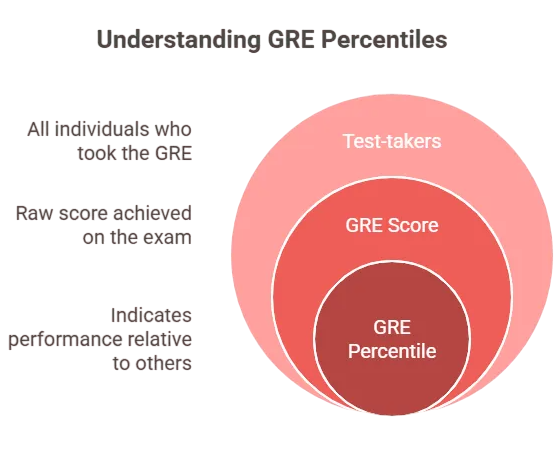
- What is a Percentile Score?
- Percentile vs Percentage
- How Percentile Score is Calculated
- Use of Percentiles in Competitive Exams
- Percentile in GATE, CAT, JEE
- Role of Percentile in College Admissions
- Percentile Score Interpretation
- Tools and Methods for Calculation
- Common Mistakes in Understanding Percentiles
- Percentile-Based Cutoffs
- How to Improve Your Percentile
- Conclusion
What is a Percentile Score?
A percentile is a statistical measure indicating the relative standing of a value within a dataset. Specifically, the nth percentile of a dataset is the value below which n percent of the observations fall. For example, if you are in the 90th percentile of an exam, your performance is better than 90% of the participants. Percentiles are used to understand and interpret data distribution, particularly in large datasets. To translate strong academic performance into career success, explore Placement and Softskills Training a targeted program that helps you build interview confidence, refine communication skills, and prepare strategically for recruitment processes across industries. They are frequently used in academic testing, medical assessments, income statistics, and other areas where relative performance matters more than absolute values. Percentile Score are categorized as:
- 25th percentile (Q1): Also called the lower quartile.
- 50th percentile (Q2): The median.
- 75th percentile (Q3): The upper quartile.
This classification is especially useful in box-and-whisker plots to display data spread and outliers.
Percentile vs Percentage
- A common misunderstanding is the difference between Percentile vs Percentage. A percentage is a simple ratio expressed as a fraction of 100. If a student scores 80 out of 100 on a test, their percentage is 80%. It indicates how many questions were answered correctly.
- A percentile, on the other hand, is a comparative ranking. If a student is in the 80th percentile, it means they have scored better than 80% of the students who took the same test. The actual score may vary based on how others performed. Therefore, percentiles offer a better way to rank individuals, especially when assessing competitive exams.
For instance, in a class of 100 students, a score that falls at the 90th percentile surpasses the performance of 90 students. This makes percentiles more dynamic and useful in comparative analysis.
To Explore Soft Skill in Depth, Check Out Our Comprehensive Soft Skill Certification Training To Gain Insights From Our Experts!
How Percentile Score is Calculated
The process of calculating percentiles involves several steps:
- Arrange Data in Ascending Order: Sort all observations from lowest to highest.
- Identify Position: Use a percentile formula like \( P = \frac{n(N+1)}{100} \), where \( P \) is the percentile position, \( n \) is the desired percentile, and \( N \) is the total number of observations.
- Interpolate If Needed: If \( P \) is not an integer, interpolate between the nearest ranks.
- Nearest Rank Method: \( P_n = \text{Rank}(\lceil \frac{n}{100} \times N \rceil) \)
- Linear Interpolation: Between closest ranks

In competitive exams like GATE or JEE, percentile calculation involves normalization, particularly when the exam is conducted in multiple sessions. The normalization process ensures fairness by accounting for varying difficulty levels.
Are You Interested in Learning More About Soft Skill ? Sign Up For Our Soft Skill Certification Training Today!
Use of Percentiles in Competitive Exams
Percentiles play a vital role in evaluating student performance across standardized tests. Since raw scores can vary due to paper difficulty, percentile scores help compare performances objectively. Percentiles help determine rankings, selection cutoffs, and eligibility.
For instance:
- A 99 percentile in JEE Main ensures a top 1% rank.
- A 95 percentile in CAT makes a candidate eligible for calls from top B-schools.
- GATE percentile assists in shortlisting candidates for PSU jobs and higher education.
Percentiles offer a normalized way to compare students across different test sessions, especially in online exams conducted over multiple days.
Percentile in GATE, CAT, JEE
Among professional and academic assessments, the competition is tough and entrance exams such as GATE, CAT, and JEE are the most influential in using percentile scoring systems to judge the potential of candidates. For example, GATE percentiles are an all-encompassing performance measure, showing the relative position of a candidate among all the test-takers in their particular engineering branch. In the same way, CAT percentiles reveal the detailed abilities of an applicant, as top management institutes set the bar very high by asking for scores above 99 percentile. To complement these academic benchmarks with strong interpersonal and presentation skills, explore Softskills Training a specialized program that helps candidates communicate effectively, present confidently, and navigate interviews with professionalism across technical and management domains. The Joint Entrance Examination (JEE) utilizes an intricate normalization method where the National Testing Agency computes percentiles for different sessions to compare the performance of candidates in Physics, Chemistry, and Mathematics in a fair way. Such standardized scoring methods pave the way for educational institutions and public sector undertakings to decide on recruitments and admissions based on real test scores turned into logical comparative evaluations that show the candidate’s actual potential and competitive advantage.
Are You Considering Pursuing a Master’s Degree in Soft Skill? Enroll in the Soft Skill Masters Program Training Course Today!
Role of Percentile in College Admissions
Percentile scores have become a major factor for college admissions in the Indian higher education scenario, which is very competitive. These scores allow a more detailed and just account of a student’s achievement. While percentiles show a comparative figure, they also consider differences between various test sessions, thus the selection procedure becomes more fair. The impact of this change is very clear in the core academic areas of engineering, management, and postgraduate courses. To give an example, engineering colleges use JEE Main percentiles for seat allocation through JoSAA counseling, whereas management institutes such as IIMs employ CAT percentiles for B-school admissions. In the same way, technical postgraduate programs use GATE percentiles for M.Tech admissions in top-tier institutes like IITs, NITs, and IISc. More and more educational institutions are declaring cutoff percentiles instead of absolute marks, thus highlighting the value of relative performance in student eligibility and shortlisting.
Are You Preparing for Soft Skill Jobs? Check Out ACTE’s Soft Skill Interview Questions & Answer to Boost Your Preparation!
Percentile Score Interpretation
Percentile scores offer insights into a candidate’s relative performance. However, interpretation depends on the exam’s difficulty and competition level. A 90 percentile in a difficult paper may be more valuable than a 95 percentile in an easier one.
- Above 99 Percentile: Top 1% of candidates. Eligible for elite institutes.
- 95–99 Percentile: Very good performance. Qualifies for good colleges.
- 85–94 Percentile: Competitive. Likely to secure mid-tier institutions.
- 70–84 Percentile: Average. Improvement required for better options.
- Below 70 Percentile: Below average. Focus on improving preparation.
Tools and Methods for Calculation
Several tools help calculate percentiles accurately. These tools are especially useful for researchers, data analysts, and educators:
Excel:
- =PERCENTILE.INC(array, k) for inclusive percentiles.
- =PERCENTILE.EXC(array, k) for exclusive percentiles.
Python:
- numpy.percentile(array, k) is commonly used in data science.
- pandas.Series.quantile() method can also be used.
R Programming:
- Use the quantile() function to compute specific percentiles.
SPSS, SAS, STATA:
- Built-in functions to generate percentile ranks.
Online Calculators:
- Several websites allow quick calculation of percentiles and percentile ranks.
These tools are especially useful for researchers, data analysts, and educators.
Common Mistakes in Understanding Percentiles
Avoiding these pitfalls can help better assess your standing and strategize improvements.
- Confusing Percentiles with Percentages: Percentiles are rankings, not scores.
- Ignoring Distribution: Percentile rank doesn’t tell you how close you are to the next percentile.
- Linear Misinterpretation: A jump from 70 to 80 percentile isn’t the same as 90 to 100 percentile; the latter may require far more improvement.
- Misreading Ties: Multiple candidates can share the same percentile.
- Overestimating Percentile Significance: High percentile doesn’t guarantee admission unless sectional percentiles are also met.
Percentile-Based Cutoffs
In the cutthroat scenario of selection for academic and professional fields, percentiles-based cutoffs have an essential function in the determination of candidates. For instance, top 2,50,000 rank holders are the only ones eligible for further consideration after JEE Main and Advanced use percentile rankings to shortlist candidates. In a similar fashion, top management institutes like IIMs adopt varying cutoff ranges between 95 to 99.9 percentiles which are dependent on the needs of the institution and can change accordingly. Besides that, Public Sector Units like BHEL, NTPC, and IOCL are also on the same page as they use percentile-based screening and generally require candidates to have a minimum 85+ percentile to be recruited. These cutoffs are not fixed but instead, they change every year due to different factors such as the total number of applicants, the difficulty of the exam, and the number of available seats, thereby making the process of selection highly competitive and adaptive.
How to Improve Your Percentile
Improving percentile is a result of strategic and academic efforts. A slight improvement in raw marks can significantly increase percentile due to the steep competition curve.
- Analyze the Exam Pattern: Understand the format, weightage, and types of questions.
- Focus on Conceptual Clarity: Strengthen core concepts to solve diverse problems.
- Take Regular Mock Tests: Simulate the exam environment and analyze each test.
- Time Management: Allocate time wisely to maximize attempts and reduce errors.
- Accuracy over Attempts: Avoid negative marking through careful answering.
- Work on Weak Areas: Identify topics that require more practice.
- Use Analytics: Tools like test series portals offer detailed performance metrics.
- Stay Consistent: Daily practice and regular revisions are key.
- Review Mistakes: Maintain an error log and revise frequently.
- Maintain Physical and Mental Health: Balanced lifestyle supports better focus.

Conclusion
Percentile Score is an essential statistical tool to understand relative performance. Unlike percentages that measure how much you scored, percentiles tell how well you did compared to others. This is why they are favored in competitive examinations and college admissions. Understanding how to interpret, calculate, and improve your percentile can help you make informed academic and career decisions. To complement your academic achievements with essential communication and interpersonal skills, explore Softskills Training a practical program designed to enhance your confidence, clarity, and collaboration abilities, ensuring you’re fully prepared for both academic interviews and professional opportunities. With the right preparation strategy, use of analytical tools, and focused efforts, you can significantly improve your percentile and increase your chances of success.





